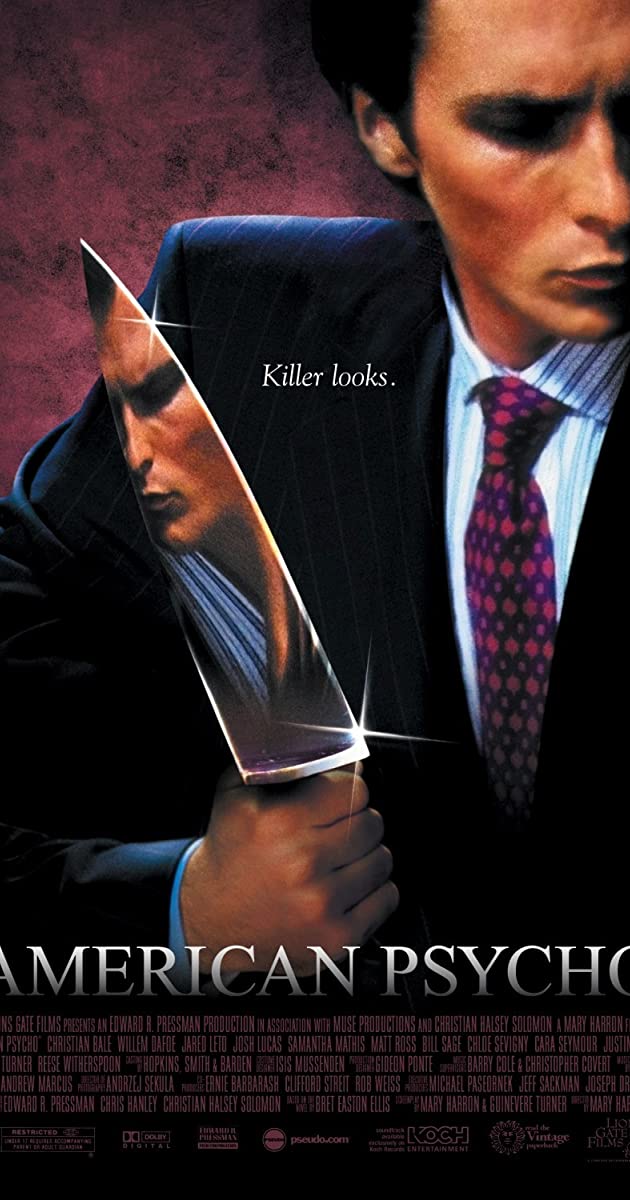The Bret Easton Ellis novel that inspired it was already contro- versial, and this film adaptation is certainly one of the most talked about movies of the year. As a picture about a psychotic, confused murderer set in the greedy Wall Street world of the 80s, “American Psycho” could be seen as a cross between Alfred Hitchcock’s Psycho and Tom Wolfe’s “The Bonfire of Vanities”. In fact, the film refers directly to those, with the main character working at Pierce & Pierce (the same firm as in “Bonfire”) and going by the name of Patrick Bateman (see the ‘Bates’ in the there?). The guy’s really f**ked, but in a fascinating way. Actor Christian Bale delivers a tour de force performance in the role, working a difficult balance between his character’s suave, arrogant high class attitude and his perverted, violent tendencies. When you think back that Leonardo DiCaprio was rumored to be interested in the part, it’s hard to see him as Bateman. Actually, Bales is so good that you can hardly imagine anyone else in his place.
The film is a very dark satire of the materialistic 80s which implies that these people with big limos and expensive suits spend so much time working on their outside image that they end up being empty inside. Early on, Bateman admits that he no longer “feels any emotion but greed and disgust”. A 27 year old Wall Street millionaire, Bateman works has anything he could ask for, yet he feels he’s lost his humanity somehow. He spends most of his days in his office making loads money, though it’s hard to define how. It seems that his job consists of showing up, telling his secretary (Chloë Sevigny) that he doesn’t take calls, bullshitting with his partners and going out to lunch or dinner in trendy restaurants. It’s a shallow, egocentric world, it’s a material world and he’s a material girl. Just look at the scene where we see him ritualistically applying countless creams and lotions to his face and body, or the whole emphasis put on being able to get reservations in the most coveted restaurants or on having the sharpest business card.
Bateman projects an image of cool and self-control, but he’s screaming inside. He sometimes cries for help and confess his crimes to his friends and fiancé (the wonderful Reese Witherspoon), but they’re all so taken with themselves that they don’t even listen. And so Bateman his left with himself and his sick ideas, and he murders more and more people with each passing day, whether it’s homeless people in alleys, escorts and prostitutes or old girlfriends. No one seems to suspect a thing until he kills a co-worker (Jared Leto) who’s moving ahead of him, and the widow hires a detective (the enjoyably sleazy Willem Dafoe) who insists on learning where was Bateman on the night of the crime…
The film was co-written and directed by Mary Harron (“I Shot Andy Warhol”), who wisely focuses more on the satirical and psychological aspects of the story then on the gruesome murders. Yes, the film is packed with scenes of people getting murdered with knives, axes, chain saws, nail guns and so on, but most of the gore is off screen. And disturbingly, many of these scenes are just hilarious. That’s due in no small part to the delightfully ironic use of 80s pop songs, which Bateman analyses and discusses passionately before going out of his mind. The film also features a lot of sex scenes, and the MPAA forced the filmmakers to take some of it out for American audiences. But ha ah! I’m Canadian, so I got to see what the big deal was all about : a scene in which Bateman is screwing two whores doggystyle while looking at himself in a mirror. That’s NC-17?!? I’ve heard somewhere that the MPAA must actually have been offended by the use of Phil Collins’ Sussudio! Never mind that, the film is directed with a lot of wit and style, and it looks absolutely gorgeous, thanks to photography by Andrzej Sekula. This is one of these films that you either love or hate. I loved it.

